Tento tutoriál vám ukáže, jak monitorovat server Ubuntu 14.04 pomocí Munin a Monit. Munin vytváří pěkné grafy o téměř každém aspektu vašeho serveru, zatímco Monit kontroluje dostupnost služeb, jako je Apache, MySQL, Postfix, a pokud zjistí, že se služba nechová podle očekávání, provede příslušnou akci, jako je restart. Kombinace těchto dvou vám poskytuje plné monitorování:grafika, která vám umožní rozpoznat aktuální nebo nadcházející problémy, a hlídací pes, který zajišťuje dostupnost monitorovaných služeb. Tento tutoriál obsahuje dvě (volitelné) kapitoly o integraci Munin a Monit do ISPConfig.
1 předběžná poznámka
Název hostitele našeho systému je server1.example.com a máme na něm web www.example.com s kořenem dokumentu /var/www/www.example.com/web.
Následující kroky je třeba provést jako uživatel root. Chcete-li se stát uživatelem root na vašem serveru, spusťte tento příkaz:
sudo su
Než začnete instalovat Munin, ujistěte se, že je systém aktuální, spusťte:
apt-get update
apt-get upgrade
Apache se používá k zobrazení stránek Munin, modul apache fcgid je vyžadován pro funkci přiblížení grafu Munin. Nainstaluji apache a modul libapache2-mod-fcgid pomocí apt.
apt-get install apache2 libcgi-fast-perl libapache2-mod-fcgid
Povolte modul fcgid v Apache.
a2enmod fcgid
2 Instalace a konfigurace Munin
Chcete-li nainstalovat Munin na Ubuntu 14.04, spusťte níže uvedené příkazy:
apt-get install munin munin-node munin-plugins-extra
Když server běží MySQL nebo MariaDB, povolte několik dalších modulů Munin pluginů pro monitorování MySQL:
cd /etc/munin/plugins
ln -s /usr/share/munin/plugins/mysql_ mysql_
ln -s /usr/share/munin/plugins/mysql_bytes mysql_bytes
ln -s /usr/share/munin/plugins/mysql_queries mysql_queries
ln -s /usr/share/munin/plugins/mysql_slowqueries mysql_slowqueries
ln -s /usr/share/munin/plugins/mysql_threads mysql_threads
Dále musíme upravit konfigurační soubor Munin /etc/munin/munin.conf. Odkomentujte řádky dbdir, htmldir, logdir, rundir a tmpldir (výchozí hodnoty jsou v pořádku). Chceme, aby Munin ve výstupu HTML používal název server1.example.com místo localhost.localdomain, proto v sekci jednoduchého hostitelského stromu nahradíme localhost.localdomain server1.example.com. Bez komentářů vypadá změněný soubor takto:
nano /etc/munin/munin.conf
# Example configuration file for Munin, generated by 'make build'
# The next three variables specifies where the location of the RRD
# databases, the HTML output, logs and the lock/pid files. They all
# must be writable by the user running munin-cron. They are all
# defaulted to the values you see here.
#
dbdir /var/lib/munin
htmldir /var/cache/munin/www
logdir /var/log/munin
rundir /var/run/munin
# Where to look for the HTML templates
#
tmpldir /etc/munin/templates
# Where to look for the static www files
#
#staticdir /etc/munin/static
# temporary cgi files are here. note that it has to be writable by
# the cgi user (usually nobody or httpd).
#
# cgitmpdir /var/lib/munin/cgi-tmp # (Exactly one) directory to include all files from. includedir /etc/munin/munin-conf.d [...] # a simple host tree
[server1.example.com]
address 127.0.0.1
use_node_name yes [...]
Měli bychom najít konfigurační soubor Apache pro Munin /etc/munin/apache.conf - definuje alias s názvem munin k výstupnímu adresáři HTML munin /var/cache/munin/www, což znamená, že můžeme k munin přistupovat ze všech webových stránek na tomto serveru pomocí relativní cesty /munin (např. http://www.example.com /munin).
Soubor apache.conf dodávaný s Ubuntu 14.04 stále obsahuje starou syntaxi Apache 2.2, která není správná pro Apache 2.4, proto tento soubor nahradíme novým. Nejprve provedeme zálohu starého souboru.
mv /etc/munin/apache.conf /etc/munin/apache.conf_bak
Otevřete nový soubor pomocí editoru:
nano /etc/munin/apache.conf
A vložte obsah níže:
Alias /munin /var/cache/munin/www
<Directory /var/cache/munin/www>
# Require local
Require all granted
Options FollowSymLinks SymLinksIfOwnerMatch
Options None
</Directory>
ScriptAlias /munin-cgi/munin-cgi-graph /usr/lib/munin/cgi/munin-cgi-graph
<Location /munin-cgi/munin-cgi-graph>
# Require local
Require all granted
Options FollowSymLinks SymLinksIfOwnerMatch
<IfModule mod_fcgid.c>
SetHandler fcgid-script
</IfModule>
<IfModule !mod_fcgid.c>
SetHandler cgi-script
</IfModule>
</Location>
Restartujte Apache:
service apache2 restart
Poté restartujte Munin:
service munin-node restart
Nyní počkejte několik minut, aby Munin mohl vytvořit svůj první výstup, a poté přejděte ve svém prohlížeči na http://www.example.com/munin/ a uvidíte první statistiky:
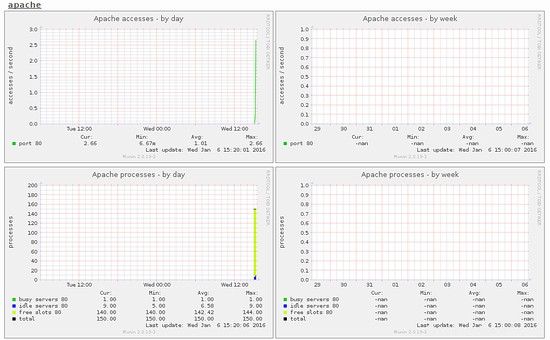
(Toto je jen malý výňatek z mnoha grafik, které munin produkuje...)
3 Ochrana výstupního adresáře Munin heslem (Volitelné, ale vysoce doporučeno)
Nyní je dobré chránit heslem výstupní adresář munin, pokud nechcete, aby každý mohl vidět každou malou statistiku o vašem serveru.
K tomu musíme vytvořit soubor s hesly /etc/munin/munin-htpasswd. Chceme se přihlásit s uživatelským jménem admin, takže uděláme toto:
htpasswd -c /etc/munin/munin-htpasswd admin
Zadejte heslo pro admin. Poté znovu otevřete /etc/munin/apache.conf...
nano /etc/munin/apache.conf
... komentovat „Vyžadovat udělení všech souhlasů a přidat řádky, které jsem označil červeně:
Alias /munin /var/cache/munin/www
<Directory /var/cache/munin/www>
# Require local
# Require all granted
AuthUserFile /etc/munin/munin-htpasswd
AuthName "Munin"
AuthType Basic
Require valid-user
Options None
</Directory>
ScriptAlias /munin-cgi/munin-cgi-graph /usr/lib/munin/cgi/munin-cgi-graph
<Location /munin-cgi/munin-cgi-graph>
# Require local
# Require all granted
AuthUserFile /etc/munin/munin-htpasswd
AuthName "Munin"
AuthType Basic
Require valid-user
<IfModule mod_fcgid.c>
SetHandler fcgid-script
</IfModule>
<IfModule !mod_fcgid.c>
SetHandler cgi-script
</IfModule>
</Location>
Poté restartujte Apache:
service apache2 restart
4 Povolit další moduly v Muninu
Příkaz Munin "munin-node-configure --suggest" lze použít k získání doporučení pro další moduly Munin, které lze na serveru povolit. Spustit:
munin-node-configure --suggest
Výstup by měl být podobný tomuto:

Sloupec "použito" ukazuje, zda je modul povolen, sloupec "Návrhy" ukazuje, zda na serveru běží služba, kterou lze monitorovat tímto modulem. Vytvořte symbolický odkaz pro modul v /etc/munin/plugins, abyste jej povolili.
Zde povolím například moduly apache_*:
cd /etc/munin/plugins
ln -s /usr/share/munin/plugins/apache_accesses
ln -s /usr/share/munin/plugins/apache_processes
ln -s /usr/share/munin/plugins/apache_volume
Restartujte Munin, aby se načetla nová konfigurace.
service munin-node restart
5 Konfigurace Munin v ISPConfig (volitelné)
ISPConfig Hosting Control Panel má možnost zobrazit data Munin v modulu ISPConfig Monitor. Data Munin se načítají do prvku iframe, protože většina prohlížečů blokuje načítání obsahu z http v rámci webu https, budeme muset najít způsob, jak získat přístup ke statistikám Munin přes SSL. Nejjednodušší způsob je použít k tomu ISPConfig vhost s povoleným SSL vytvořením symbolického odkazu uvnitř webového adresáře ISPConfig na datový adresář Munin www.
ln -s /var/cache/munin/www /usr/local/ispconfig/interface/web/munin
Nyní můžeme přistupovat k Muninu v prohlížeči pomocí https://server1.example.com:8080/munin prostřednictvím ISPConfig apache vhost.
Dalším krokem je přidání konfigurace do ISPConfig.
Přihlaste se do ISPConfig jako uživatel Administrator (admin) a přejděte do System> Server config, vyplňte URL, uživatelské jméno a heslo pro Munin, jak je uvedeno níže.
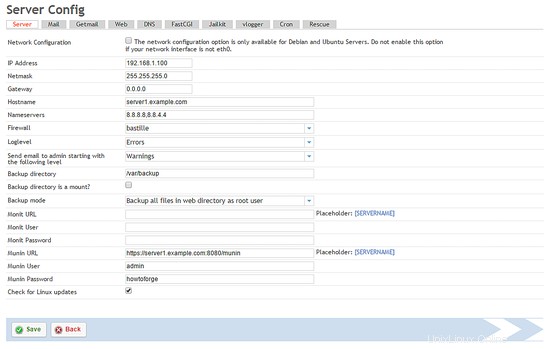
Ujistěte se, že v munin URL používáte https:// a port 8080.
6 Instalace a konfigurace Monit
Chcete-li nainstalovat Monit, provedeme toto:
apt-get install monit
Nyní musíme upravit /etc/monit/monitrc. Výchozí /etc/monit/monitrc má spoustu příkladů a další příklady konfigurace můžete najít na http://mmonit.com/monit/documentation/. V mém případě však chci sledovat proftpd, sshd, mysql, apache a postfix, chci povolit webové rozhraní Monit na portu 2812, chci webové rozhraní https, chci se přihlásit do webového rozhraní pomocí uživatelského jména admin a heslo howtoforge a chci, aby Monit zasílal e-mailová upozornění na [email protected], takže můj soubor vypadá takto (do konfigurace jsem přidal příklady pro jiné démony, abyste si mohli soubor upravit podle svých potřeb):
cp /etc/monit/monitrc /etc/monit/monitrc_orig
cat /dev/null > /etc/monit/monitrc
nano /etc/monit/monitrc
set daemon 60
set logfile syslog facility log_daemon
set mailserver localhost
set mail-format { from: [email protected] }
set alert [email protected]
set httpd port 2812 and
SSL ENABLE
PEMFILE /var/certs/monit.pem
allow admin:howtoforge
check process sshd with pidfile /var/run/sshd.pid
start program "/usr/sbin/service ssh start"
stop program "/usr/sbin/service ssh stop"
if failed port 22 protocol ssh then restart
if 5 restarts within 5 cycles then timeout
check process apache with pidfile /var/run/apache2/apache2.pid
group www
start program = "/usr/sbin/service apache2 start"
stop program = "/usr/sbin/service apache2 stop"
if failed host localhost port 80 protocol http
and request "/monit/token" then restart
if cpu is greater than 60% for 2 cycles then alert
if cpu > 80% for 5 cycles then restart
if totalmem > 500 MB for 5 cycles then restart
if children > 250 then restart
if loadavg(5min) greater than 10 for 8 cycles then stop
if 3 restarts within 5 cycles then timeout
#check process mysql with pidfile /var/run/mysqld/mysqld.pid
# group database
# start program = "/usr/sbin/service mysql start"
# stop program = "/usr/sbin/service mysql stop"
# if failed host 127.0.0.1 port 3306 then restart
# if 5 restarts within 5 cycles then timeout
#check process proftpd with pidfile /var/run/proftpd.pid
# start program = "/usr/sbin/service proftpd start"
# stop program = "/usr/sbin/service proftpd stop"
# if failed port 21 protocol ftp then restart
# if 5 restarts within 5 cycles then timeout
#
#check process postfix with pidfile /var/spool/postfix/pid/master.pid
# group mail
# start program = "/usr/sbin/service postfix start"
# stop program = "/usr/sbin/service postfix stop"
# if failed port 25 protocol smtp then restart
# if 5 restarts within 5 cycles then timeout
#
#check process nginx with pidfile /var/run/nginx.pid
# start program = "/usr/sbin/service nginx start"
# stop program = "/usr/sbin/service nginx stop"
# if failed host 127.0.0.1 port 80 then restart
#
#check process memcached with pidfile /var/run/memcached.pid
# start program = "/usr/sbin/service memcached start"
# stop program = "/usr/sbin/service memcached stop"
# if failed host 127.0.0.1 port 11211 then restart
#
#check process pureftpd with pidfile /var/run/pure-ftpd/pure-ftpd.pid
# start program = "/usr/sbin/service pure-ftpd-mysql start"
# stop program = "/usr/sbin/service pure-ftpd-mysql stop"
# if failed port 21 protocol ftp then restart
# if 5 restarts within 5 cycles then timeout
#
#check process named with pidfile /var/run/named/named.pid
# start program = "/usr/sbin/service bind9 start"
# stop program = "/usr/sbin/service bind9 stop"
# if failed host 127.0.0.1 port 53 type tcp protocol dns then restart
# if failed host 127.0.0.1 port 53 type udp protocol dns then restart
# if 5 restarts within 5 cycles then timeout
#
#check process ntpd with pidfile /var/run/ntpd.pid
# start program = "/usr/sbin/service ntp start"
# stop program = "/usr/sbin/service ntp stop"
# if failed host 127.0.0.1 port 123 type udp then restart
# if 5 restarts within 5 cycles then timeout
#
#check process mailman with pidfile /var/run/mailman/mailman.pid
# group mail
# start program = "/usr/sbin/service mailman start"
# stop program = "/usr/sbin/service mailman stop"
#
#check process amavisd with pidfile /var/run/amavis/amavisd.pid
# group mail
# start program = "/usr/sbin/service amavis start"
# stop program = "/usr/sbin/service amavis stop"
# if failed port 10024 protocol smtp then restart
# if 5 restarts within 5 cycles then timeout
#
#check process courier-imap with pidfile /var/run/courier/imapd.pid
# group mail
# start program = "/usr/sbin/service courier-imap start"
# stop program = "/usr/sbin/service courier-imap stop"
# if failed host localhost port 143 type tcp protocol imap then restart
# if 5 restarts within 5 cycles then timeout
#
#check process courier-imap-ssl with pidfile /var/run/courier/imapd-ssl.pid
# group mail
# start program = "/usr/sbin/service courier-imap-ssl start"
# stop program = "/usr/sbin/service courier-imap-ssl stop"
# if failed host localhost port 993 type tcpssl sslauto protocol imap then restart
# if 5 restarts within 5 cycles then timeout
#
#check process courier-pop3 with pidfile /var/run/courier/pop3d.pid
# group mail
# start program = "/usr/sbin/service courier-pop start"
# stop program = "/usr/sbin/service courier-pop stop"
# if failed host localhost port 110 type tcp protocol pop then restart
# if 5 restarts within 5 cycles then timeout
#
#check process courier-pop3-ssl with pidfile /var/run/courier/pop3d-ssl.pid
# group mail
# start program = "/usr/sbin/service courier-pop-ssl start"
# stop program = "/usr/sbin/service courier-pop-ssl stop"
# if failed host localhost port 995 type tcpssl sslauto protocol pop then restart
# if 5 restarts within 5 cycles then timeout
#
#check process dovecot with pidfile /var/run/dovecot/master.pid
# group mail
# start program = "/usr/sbin/service dovecot start"
# stop program = "/usr/sbin/service dovecot stop"
# if failed host localhost port 143 type tcp protocol imap then restart
# if 5 restarts within 5 cycles then timeout
Konfigurační soubor je docela samovysvětlující; pokud si nejste jisti některou možností, podívejte se na dokumentaci Monit:http://mmonit.com/monit/documentation/monit.html
V části Apache konfigurace Monit najdete toto:
if failed host localhost port 80 protocol http
and request "/monit/token" then restart
což znamená, že se Monit pokusí připojit k localhost na portu 80 a pokusí se získat přístup k souboru /monit/token, což je /var/www/html/monit/token, protože kořen dokumentu naší webové stránky je /var/www/html. Pokud Monit neuspěje, znamená to, že Apache neběží a Monit jej restartuje. Nyní musíme vytvořit soubor /var/www/html/monit/token a napsat do něj nějaký náhodný řetězec:
mkdir /var/www/html/monit
echo "hello" > /var/www/html/monit/token
Dále vytvoříme pem cert (/var/certs/monit.pem), který potřebujeme pro webové rozhraní Monit šifrované SSL:
mkdir /var/certs
cd /var/certs
K vytvoření našeho certifikátu potřebujeme konfigurační soubor OpenSSL. Může to vypadat takto:
nano /var/certs/monit.cnf
# create RSA certs - Server RANDFILE = ./openssl.rnd [ req ] default_bits = 2048 encrypt_key = yes distinguished_name = req_dn x509_extensions = cert_type [ req_dn ] countryName = Country Name (2 letter code) countryName_default = MO stateOrProvinceName = State or Province Name (full name) stateOrProvinceName_default = Monitoria localityName = Locality Name (eg, city) localityName_default = Monittown organizationName = Organization Name (eg, company) organizationName_default = Monit Inc. organizationalUnitName = Organizational Unit Name (eg, section) organizationalUnitName_default = Dept. of Monitoring Technologies commonName = Common Name (FQDN of your server) commonName_default = server.monit.mo emailAddress = Email Address emailAddress_default = [email protected] [ cert_type ] nsCertType = server
Nyní vytvoříme certifikát takto:
openssl req -new -x509 -days 365 -nodes -config ./monit.cnf -out /var/certs/monit.pem -keyout /var/certs/monit.pem
openssl gendh 1024 >> /var/certs/monit.pem
openssl x509 -subject -dates -fingerprint -noout -in /var/certs/monit.pem
chmod 600 /var/certs/monit.pem
Konečně můžeme spustit Monit:
service monit start
Nyní nasměrujte svůj prohlížeč na https://www.example.com:2812/ (ujistěte se, že port 2812 není blokován vaším firewallem), přihlaste se pomocí admin a howtoforge a měli byste vidět webové rozhraní Monit. Mělo by to vypadat takto:

(Hlavní obrazovka)
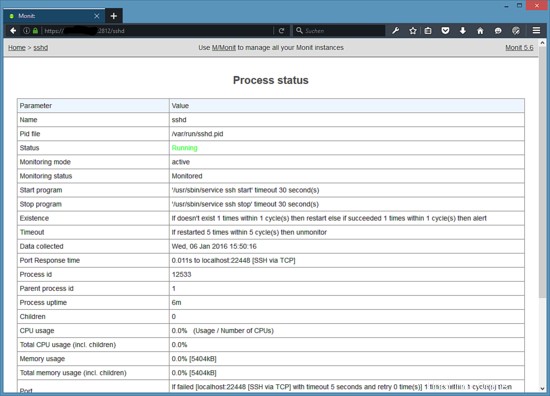
(Stránka stavu SSHd)
V závislosti na vaší konfiguraci v /etc/monit/monitrc monit restartuje vaše služby, pokud selžou, a odešle e-maily s upozorněním, pokud se změní ID procesů služeb atd.
Chcete-li získat stav Monit na shell, spusťte příkaz "monit status":
monit status
Příkaz zobrazí stav všech sledovaných služeb.
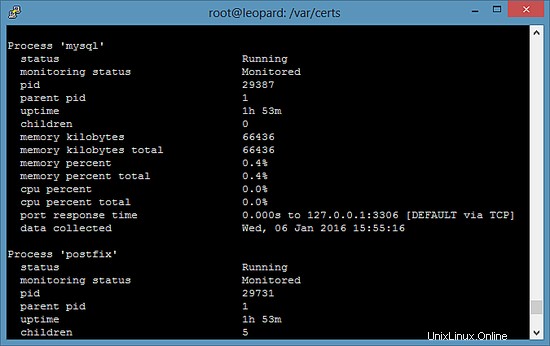
7 Konfigurace Monit v ISPConfig
Ovládací panel serveru ISPConfig může zobrazit data Monit v jeho modulu Monitor. Chcete-li tuto funkci povolit v ISPConfig, přihlaste se do ISPConfig jako uživatel Administrator (admin), přejděte do System> Server config, vyplňte URL, uživatelské jméno a heslo pro Monit, jak je uvedeno níže.
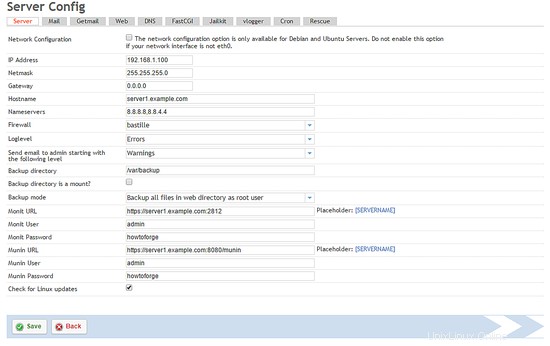
8 odkazů
- munin:http://munin-monitoring.org/
- monit:http://mmonit.com/monit/